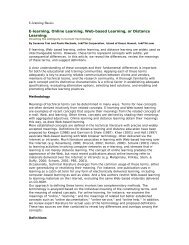Blended Learning: What Works?
Blended Learning: What Works?
Blended Learning: What Works?
You also want an ePaper? Increase the reach of your titles
YUMPU automatically turns print PDFs into web optimized ePapers that Google loves.
<strong>Blended</strong> <strong>Learning</strong>: <strong>What</strong> <strong>Works</strong>they’re doing to take this course or program?” <strong>What</strong>’s in it for them? Once youknow that, how do you communicate that to them and their managers?Deployment and Support• Every possible deployment method is needed:• CD-Rom• Conference Calls• Performance Aids• Webinars• Web-based based coursesDeployment processesmake or breakthe program.• Do NOT assume that learners have access to theinternet• Do NOT assume that learners have high bandwidth• Do NOT assume that learner’s PCs are “ready”38 © Bersin & Associates<strong>Blended</strong> <strong>Learning</strong>: <strong>What</strong> <strong>Works</strong>7. <strong>Blended</strong> learning does not have to cost Millions. You can build your owncontent.Another interesting finding. Many companies outsource major e-learning projects – andsometimes spend millions of dollars. One of our research companies spent millions ofdollars creating a business simulation which trained financial professionals how to usenew accounting principles. In this particular case, the problem was global – and the costof failure was very high – so it was worth the cost. If you have a very large audience anda very big problem, you can cost-justify a lot of money on content.(The simple cost equation for blended learning is the tradeoff between development costand delivery cost. For web-based training, for example, high development costs can beamortized by low delivery costs if the audience is large. For classroom training, lowerdevelopment costs and higher delivery costs are justified when the audience is small.)However in most cases what we found was the opposite. Companies are now developingweb-based content for $100’s per instructor hour (we used to charge $30-70,000 perinstructor hour in my prior life!). How do they do this? They often hire a vendor to“teach them” how to build courseware – then they get a small team together (3-4 people)and build the content internally. This appears to be a major trend.One company developed a major SAP upgrade program which was business criticalacross more than 10,000 employess for a total development cost of $75,000. This is lessthan $7.50 per employee for development cost – the cost of lunch in most big cities.© Bersin & Associates 8 May 2003









